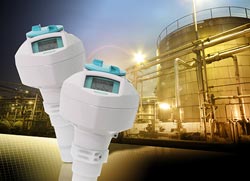Threaded PVDF antenna opens up new applications for radar level transmitter

A threaded PVDF antenna opens up new applications for liquid and slurry measurement in extreme conditions for Siemens Industry Automation Division's non-contacting level transmitter Sitrans LR250.<br>
The antenna opens up new applications in extreme conditions for this non-contacting level transmitter.
The Siemens Industry Automation Division's Sitrans LR250 threaded PVDF antenna is designed for extreme conditions characteristic of acids, alkalis, and other corrosive chemicals: some examples include sodium hypochlorite, sodium hydroxide, and sulfuric and hydrochloric acid applications. These applications are not suitable for stainless steel and usually require transmitters be made from exotic and costly materials. However, the Sitrans LR250 threaded PVDF antenna is able to withstand such environments while remaining a cost-effective solution. It also uses FDA-compliant materials suitable for use in food and beverage, chemical, and water treatment applications.
Sitrans LR250 is a compact 25 GHz 2-wire transmitter for non-contacting level measurement of liquid or slurry materials for measurement ranges of up to 20 m (66 ft). It is available with Hart, Profibus PA, or Foundation Fieldbus protocols. With the graphical Quick Start Wizard the Sitrans LR250 is operational in minutes and the infrared handheld programmer supports local programming. Full function diagnostics comply with Namur NE 43 and the Sitrans LR250 has also achieved a SIL 2 functional safety declaration with Safe Failure Fraction (SFF) of 86%, making it suitable for use in Safety Instrumented Systems (SIS). Key fields of application for the Sitrans LR250 include bulk liquid storage tanks, process vessels with agitators, vaporous liquids and low dielectric media.
The Siemens Industry Sector (Erlangen, Germany) is the world's leading supplier of innovative and environmentally friendly products and solutions for industrial customers. With end-to-end automation technology and industrial software, solid vertical-market expertise, and technology-based services, the Sector enhances its customers' productivity, efficiency, and flexibility. With a global workforce of more than 100,000 employees, the Industry Sector comprises the Divisions Industry Automation, Drive Technologies and Customer Services as well as the Business Unit Metals Technologies. For more information, visit http://www.siemens.com/industry
The Siemens Industry Automation Division (Nuremberg, Germany) supports the entire value chain of its industrial customers – from product design to production and services – with an unmatched combination of automation technology, industrial control technology, and industrial software. With its software solutions, the Division can shorten the time-to-market of new products by up to 50 percent. Industry Automation comprises five Business Units: Industrial Automation Systems, Control Components and Systems Engineering, Sensors and Communications, Siemens PLM Software, and Water Technologies. For more information, visit http://www.siemens.com/industryautomation
Reference Number: IIA2011112902e
Contact
Mr. Peter Jefimiec
Industry Automation Division
Siemens AG
Gleiwitzerstr. 555
90475 Nuremberg
Germany
Tel: +49 (911) 895-7975
peter.jefimiec@siemens.com
Media Contact
More Information:
http://www.siemens.com/sitranslr250All latest news from the category: Machine Engineering
Machine engineering is one of Germany’s key industries. The importance of this segment has led to the creation of new university degree programs in fields such as production and logistics, process engineering, vehicle/automotive engineering, production engineering and aerospace engineering among others.
innovations-report offers informative reports and articles covering technologies such as automation, motion, power train, energy, conveyor, plastics, lightweight construction, logistics/warehousing, measurement systems, machine tools and control engineering.
Newest articles

Innovative 3D printed scaffolds offer new hope for bone healing
Researchers at the Institute for Bioengineering of Catalonia have developed novel 3D printed PLA-CaP scaffolds that promote blood vessel formation, ensuring better healing and regeneration of bone tissue. Bone is…

The surprising role of gut infection in Alzheimer’s disease
ASU- and Banner Alzheimer’s Institute-led study implicates link between a common virus and the disease, which travels from the gut to the brain and may be a target for antiviral…

Molecular gardening: New enzymes discovered for protein modification pruning
How deubiquitinases USP53 and USP54 cleave long polyubiquitin chains and how the former is linked to liver disease in children. Deubiquitinases (DUBs) are enzymes used by cells to trim protein…



